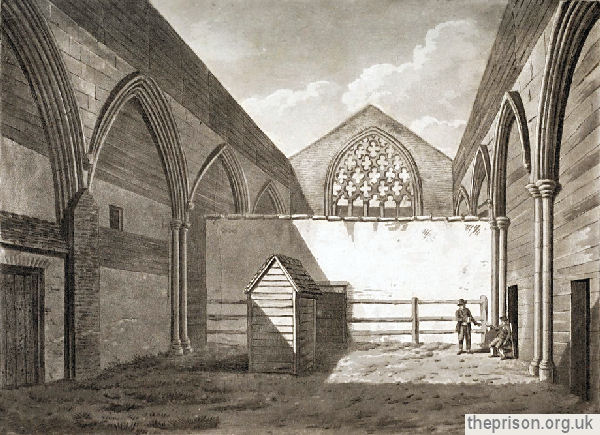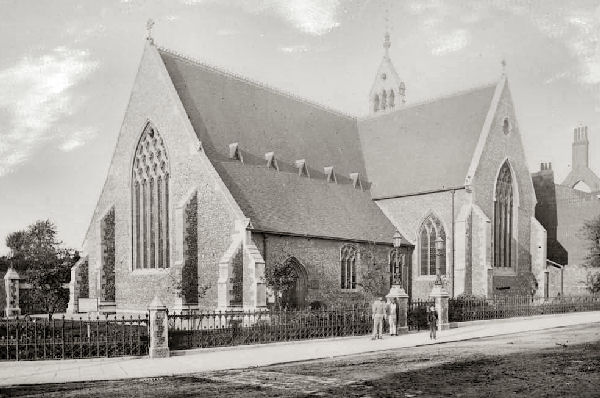Town and County Bridewell, Reading, Berkshire
The Reading Town Bridewell, or House of Correction, was established in 1590 on Friar Street, Reading. It occupied the Greyfriars Church, which Henry VIII had given to the town in 1540, following the dissolution. In the intervening hal century, it had first been used as a town hall and then as a hospital for the poor. The premises also served as a county bridewell until 1786, when a new county bridewell was erected on Forbury Hill (now Forbury Road).
In 1784, John Howard reported on the prison as follows:
On Howard's visits between 1776 and 1782, the number of inmates had varied from six to thirteen.
Another account of the establishment was provided in around 1808 by John Man:
The roofless church is shown in the illustration below:

Town Bridewell, Reading, early c.1816.
Finally, a description by James Neild from 1812:
Keeper, John Shailer. Salary, 10l. No Fees.
Divine Service never performed here.
Surgeon, Mr. Bulley; makes a Bill.
Number of Prisoners, 1801, Dec. 13th, three; 1806, Oct. l6th, three.
Allowance, was sixpence each; now only fourpence each per day.
Here is a courtyard for the Men, 48 feet by 27, and under an arcade are two hemp-blocks. They have no day-room, but four sleeping-cells, of 15 feet by 9, and 8 feet high, which open into a small court-yard, 6 feet 9 inches square, and are lighted by a little iron-grating over each door. In one of these was the Male-Prisoner confined. No firing or candle allowed by the Corporation : Straw only for bedding on the floors.
Opposite to those cells is another court-yard, 17 feet by 9; in which is a fifth sleeping-cell, of 9 feet by 7 feet 6 inches, entirely dark, except what light is occasionally thrown in through a pot-hole, or small aperture in the door, of 8 inches by 5. Over this cell is an ascent by a fifteen-step ladder, to another room of 9 feet 6 by 6 feet 6, and 8 feet high, lighted by a small iron-barred window.
The Women's court-yard is 27 feet square; with a draw-well in the centre, and a sewer. Their day-room, 12 feet by 10 feet 6 inches, has a bricked floor, a glazed window, and a fire-place, but no grate. Their sleeping-room adjoining is 16 feet by 10, and 6 feet 4 inches high, with straw on the floor, but no light, except as admitted by a small iron-grating in the door, of 13 inches by 11. The two Women Prisoners were lodged here.
Water, heretofore inaccessible to the Prisoners, is now properly supplied. Whatever be their employment, they have the produce of their earnings.
At a Town council meeting in May 1838, the Mayor reported that the bridewell was in a very dilapidated state, and unfit for the purpose of imprisonment. He proposed that it must either be rebuilt or some other place provided forthwith, as the expense of sending prisoners to the County gaol was double the cost of keeping them in the Town gaol. Councillor Micklem said he thought a new Bridewell not desirable, as the expense would be very great.
No further action appears to have resulted and by the 1850s the building was derelict. Jn the 1860s, however, it was bought by a local clergyman, the Rev. William Phelps, restored and reconsecrated in 1863.

The restored Greyfriars Church, Reading.
Records
Note: many repositories impose a closure period of up to 100 years for records identifying individuals. Before travelling a long distance, always check that the records you want to consult will be available.
- Berkshire Record Office, Berkshire Record Office, 9 Coley Avenue, Reading, Berks RG1 6AF. Holdings include: Calendars of prisoners (January 1778, April and July 1783, and October 1784).
- The National Archives, Kew, Richmond, Surrey, TW9 4DU. Has a wide variety of crime and prison records going back to the 1770s, including calendars of prisoners, prison registers and criminal registers.
- Find My Past has digitized many of the National Archives' prison records, including prisoner-of-war records, plus a variety of local records including Manchester, York and Plymouth. More information.
- Prison-related records on
Ancestry UK
include Prison Commission Records, 1770-1951
, and local records from London, Swansea, Gloucesterhire and West Yorkshire. More information.
- The Genealogist also has a number of National Archives' prison records. More information.
Bibliography
- Higginbotham, Peter The Prison Cookbook: A History of the English Prison and its Food (2010, The History Press)
- Brodie, A. Behind Bars - The Hidden Architecture of England's Prisons (2000, English Heritage)
- Brodie, A., Croom, J. & Davies, J.O. English Prisons: An Architectural History (2002, English Heritage)
- Harding, C., Hines, B., Ireland, R., Rawlings, P. Imprisonment in England and Wales (1985, Croom Helm)
- McConville, Sean A History of English Prison Administration: Volume I 1750-1877 (1981, Routledge & Kegan Paul)
- Morris, N. and Rothman, D.G. (eds.) The Oxfod History of the Prison (1997, OUP)
- Pugh R.B. Imprisonment in Medieval England (1968, CUP)
Links
- Prison Oracle - resources those involved in present-day UK prisons.
- GOV.UK - UK Government's information on sentencing, probation and support for families.
Except where indicated, this page () © Peter Higginbotham. Contents may not be reproduced without permission.



